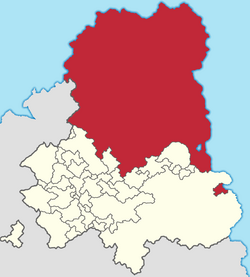Tschintiessteiss
Kingdom of Tschintiessteiss Tranzrööss Tschörntischee tranzh-rós-chorn-ti-shé | |
|---|---|
Motto: Tåchzåss tschö schans eschitöm ‘Gods with us’ | |
 TSC (and colonies) within the Gintem Confederation. | |
 Location of Tschintiessteiss in the Gintem Confederation | |
| Capital and largest city | Dusorson |
| Official languages | Tschintierst |
| Demonym(s) | Tschintierst |
| Government | Unitary semi-constitutional parliamentary monarchy |
• King | Ytytschooryn Wechtachz |
• Seer | Unoorooss Achseschriibü |
| Legislature | Tranzgenschaden |
| State in the Gintem Confederation | |
• Founding of the Margravate of Tschintiessteiss | 3516 CY |
| Area | |
• | 360,146 km2 (139,053 sq mi), not including colonial possessions |
| Population | |
• 4620 census | 42,316,501, not including colonial possessions. See Population of Tschintiessteiss for more info. |
• Density | 117.50/km2 (304.3/sq mi) |
| Currency | Muchon |
Tschintiessteiss (/ˈt͡ʃɪnti:staɪs, -tɪs-/; Tschintierst: chorn-ti-shé Tschörntischee), often abbreviated as TSC, is a country located in Northeastern Yazland. A powerful country within the Gintem Confederation, it is at the forefront of military and technological progress, and was the victor of the Copper War. It borders Dhimrai to the West; as well as Dröövache, Üü, Muurågo, Tschuchåschotscho, Hinzgööss, Wörwritschööss, Hebratsche, and Küüztschüüsches to the South. Tschintiessteiss also has various colonial possessions that range from Churyko to Jarruunh. TSC has the largest population in Yazland, and the Xth largest in the world. The Gintem people have inhabited TSC since the fall of the Doccábhan Empire in the 34th century CY, shortly after the Gintem migrations. Following their migration into the area, the Gintem Confederation was established as a state that would serve all Gintem peoples. This confederation would last until the modern day, but quickly became largely decentralized and trans-national rather than a national entity by itself. TSC would get its start as the Margravate of Tschintiessteiss in 3516 CY, and would grow over the years through conquest and diplomacy. TSC would finally gain major influence following its victory in the Great Gintem War, a religious war concerning the status of Kunwidya within the confederation. Following the X reforms, TSC would become the premier state within the confederation, and would develop a rivalry with their western neighbor Dhimrai. In the 46th Century, TSC would become a center of technological and scientific progress, creating many new impressive technologies in the so-called “Golden 46th century.” The Golden 46th century would end following the breakout of the Copper War in Yazland, which saw the brief unification of the Gintem Confederation under TSC. After their victory in the war, TSC would suffer an economic depression, and public discontent surrounding the military and nobility’s policies during the Copper War. X
Etymology
History
Bronze age collapse and Yasgan migrations
Gintem Migration
During the 2600s CY, various Milevic groups migrating around the Narrow Sea had caused the displacement of numerous Gintem Groups. Forcing their migration northwards towards the modern day location of the Gintem Confederation. Many simply settled in the lands inhabited by the X, with little known as to if such settlement was peaceful or not; but as the Milevic Migration continued, more and more Gintem groups began to migrate northwards.
Fall of the Doccábhan Empire and the Gintem Confederation
Following the X War and subsequent collapse of the Doccábhan Empire, Sendeasta Missisin established the Gintem Confederation, a loose alliance of all the various Gintem tribes that had rallied together to fight against the Doccábhans. Under her leadership, the various tribal peoples of the confederation began to divide the land of the rich Doccábhan East amongst themselves. After her death, the Gintem remained in place as a semi-trans-national entity, meant as a central mediator for disputes between the various feuding kings that followed the collapse of the Doccábhan Empire. Maircességte Múrnaisse, also known as Maircességte the Great, codified the governance of the Gintem based on the ideals of the Doccábhan Empire. He rolled back the direct opposition to the Doccábhans, and instead positioned the Gintem as the new successor of a series of Yasgan Empires. Traditional inheritance laws required that each eligible heir be given a share of their parent’s land after passing, this resulted in the Gintem Confederation becoming a patchwork of several independent entities, meaning the Archking Paramount of the Gintem became less and less able to settle disputes between a majority of member-states. In addition, the practice of Missisinic Succession would further divide the confederation until its outlaw in 3463 CY.
Margravate of Tschintiessteiss
Tschintiessteiss would be founded in 3516 CY, as the Margravate of Tschintiessteiss, a small realm carved out of the Doccábh remnant states of the north. The Margravate was founded by Ysyschodyn the Bear, who conquered the lands during the tumultuous period of the Grand Conquests. The Margravate would remain a mostly minor state contained to the northwest of the Gintem Confederation. Throughout the 36th century, the Margraves of Tschintiessteiss would engage in mostly petty conquests, gaining some fiefs further inland. Though the common people of the Margravate were mostly poor, local nobles grew rich through tariffs on the Triangle Sea Trade. Tschintiessteiss would support a heavily militarized and war-hungry noble class, who would quickly win conflicts using their knights with well-crafted weapons and armor. Tschintiessteiss would establish itself as a local power, finding allies in the Margravate of Maarküche and the Duchy of Såskybuutscho.
Principality of Tschintiessteiss
Kingdom of Tschintiessteiss
Great Gintem War
Throughout the 41st and 44th centuries, the Gintem Confederation along with neighboring states would experience a wave of Kunwidya missionaries. With the rise of the Phelo Empire, the northern hemisphere would become dominated by the Kunwidya faith. As Kunwidya was slowly adopted by various Gintem states, a rift began to emerge between those worshipping the old pantheon and those worshipping Widya. Seeking to challenge to traditional power structures of the Gintem Confederation, they would form the Heavenly League to push their interests. This would make Kunwidya a major partisan issue, and non-Kunwidya states would quickly form the Grand Coalition to prevent any further erosion of traditional power structures and cultural practices. Following the Gistetschö succession crisis in 4326, the entire Gintem would be brought into civil war.
Copper War
Post-War
Postwar TSC was subject to heavy reorganization after the death of the mad king was made public. Many of the old order officers were arrested and either executed or imprisoned for life. This purge of the highest military leadership has lead to disorganization and confusion amongst the army and the public, as many government secrets have been kept classified.
Geography
Geology
Climate
Biodiversity
Politics
Government
TSC is a semi-constitutional parliamentary monarchy where the king controls a significant amount of executive power. While the legislature does have control over lawmaking and internal affairs, the word of the king is incontestable. TSC has a unicameral legislature known as the Tranzgenschaden, in which there are X representatives. Representatives are elected from provinces, and each province has a certain number of representatives. TSC has universal male suffrage, though landowning males over 30 elect a certain percentage of the representatives, while non-landowning males over 30 elect the rest. There are no term limits of any kind in TSC. The Tranzgenschaden has the power to to propose and pass legislation, to elect a Schüchitsch, to manage the overseas colonial possessions of TSC, to declare war, and to organize and budget internal ministries. The Schüchitsch is the head of government of TSC, and handles many of the same duties that the King does. They are the the official representative of the will of the king, and is accountable mostly only to him. The Schüchitsch, aside from being elected by the Tranzgenschaden, may also be chosen by the king directly.
Administration
There are 11 ministries of the Royal Government, each of which has their head appointed by the current Seer, or the King himself. The ministries manage various domestic or foreign interests and affairs, and are further subdivided into domains. Domains are more specialized government agencies that handle specific roles or projects, such as the Domain of National Rail Operation or the Domain of State Foresight.
Administrative divisions
Tschintiessteiss as a country is divided into 83 provinces, and they fall directly under crown control. TSC also has a vast overseas empire that is divided into 11(?) Overseas Territorial Crown Possessions.
Foreign relations
Since 45XX, Tschintiessteiss has led a defensive coalition of nations in the Central Powers. The Central Powers, officially known as the Alliance for Protection between the Central Nations of North Yazland and Associated Allies, was responsible for coming to the defense of TSC in the Copper War, collaborating to eventually defeat the Quintuple Entente. Since the end of the Copper War the alliance was maintained in the name of peace and stability in Yazland.

